Welcome to Cleveland, Where the Browns Are True Contenders

This story appears in the Aug. 26–Sept. 2, 2019, issue of Sports Illustrated. For more great storytelling and in-depth analysis, subscribe to the magazine—and get up to 94% off the cover price. Click here for more.
Here it lies, sepulchral and stained from a decade of degradation, neatly folded so that none of the 29 names on the back are visible. The infamous Browns quarterback jersey. The one with COUCH sewn on at the top and then a seemingly interminable list of recent would-be saviors—from WYNN to QUINN, MANZIEL to MCCOWN—each handwritten on duct tape, crossed out and affixed below the previous one, creating a cascading column of disappointment. Today the relic rests inside a cardboard container labeled BOX OF SADNESS, entombed in the storage closet of a Cleveland advertising agency, alongside a dozen such receptacles. The others hold papers waiting to be shredded.
Tim Brokaw, a local ad exec, crafted the jersey back in 2007. There were only 10 names at the beginning, but the list quickly grew, and so did the attention. Eventually Brokaw took to displaying the gag uniform on a mannequin in a window of his office, across from the Browns’ stadium, where fans would congregate, uniting in their misery. Soon it began to represent something more.
For so long now it has symbolized this team, this city, once a ventricle of industrial America, now the brunt of ubiquitous mockery. In the 20 seasons since the Browns were reestablished as an expansion franchise, they have been the least successful, most dysfunctional organization in the NFL: a .298 winning percentage, nine general managers, 11 coaches. Just 18 months ago they were capping off the worst three-season stretch ever.
But something unimaginable was building in the background of that pain. Years of concerted demolition followed by a complete and rapid rebuild, a confluence of events both savvily plotted and serendipitously stumbled upon, led to this unforeseeable reality: The Browns enter 2019 with the sixth-best odds to win Super Bowl LIV. This team has not only talent in abundance but also an identity that reflects its city, with a cast-off, nose-to-the-grindstone GM; a long-toiling, nothing-came-easy coach; an undersized QB, constantly circling (or inventing) slights; and two exiled receivers, each looking to reshape his narrative.
It’s no coincidence, those in northern Ohio believe, that the franchise is coming full circle as the NFL celebrates its 100th anniversary. The league was born an hour south, in Canton; the state yielded four of the first five champions; and the Browns were a preeminent early dynasty. Even after years of heartbreak, after owner Art Modell whisked the original team away to Baltimore; even after a singular futility since returning, with just one postseason appearance in two decades, the fans have largely remained.
“It seems Jesus has been at work,” says Hall of Fame back Jim Brown, who retired shortly after the Browns’ last title appearance, in 1966. “It is almost like: Cleveland is now back on top, like it should be.”
But these inflated hopes, in a city that for so long has accepted the inevitability of disappointment, under a first-year coach and a second-year QB and a collection of players seen as emotionally volatile, could lead one to see this team as something other than blessed. And wouldn’t it be fitting in this city, of all cities, if greater anticipation led only to greater disappointment?
Comedian Mike Polk, who memorably dubbed the Browns’ stadium a “factory of sadness,” can’t shake the idea that his city’s fans are now something like the titular character in Stephen King’s Carrie. “We’ve just been crowned prom queen,” Polk says. “Everyone’s cheering and we’re smiling and waving, blissfully unaware of the bucket of pig’s blood dangling over our head.”
Welcome to Cleveland.
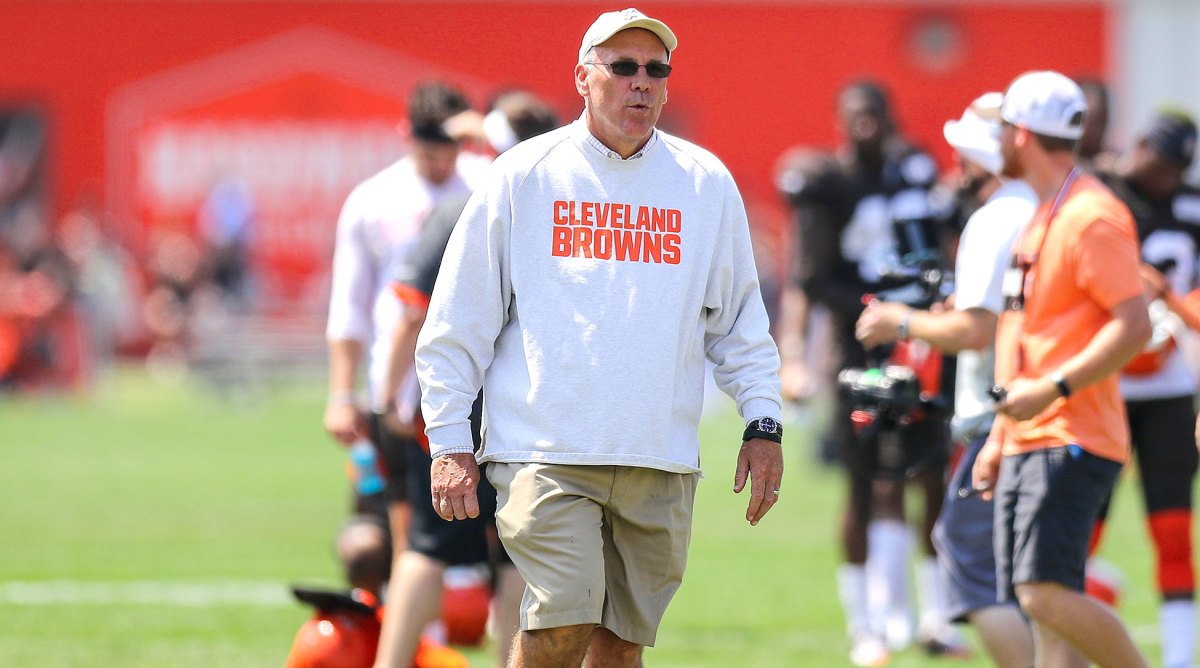
John Dorsey, clad in his usual khaki shorts and Browns sweatshirt and beige hat with the old Brownie elf logo, flips through his iPhone, showing off photos he’s taken over the past 18 months of fans and their intricately customized Browns-themed vehicles. The guy he ran into at a 7-Eleven who had an antique car painted in team colors ... the school bus with a dog face and helmet covering the windshield. He encounters these hardcores all over the country, always has, even when he played linebacker for the Packers in the 1980s and in every airport spotted Clevelanders proudly displaying their devotions. “Five of the original [14] teams are from Ohio,” he says, ticking off the names: Akron Pros, Dayton Triangles. ... “Football means something in this area.”
After Dorsey’s playing career ended, he climbed the Green Bay org chart, from low-level scout to director of football operations. The Chiefs hired him as their GM in 2013, and in four years he built one of the league’s most competitive rosters, averaging double-digit wins—until he was fired in June ’17, after consecutive AFC division-round playoff losses.
Dorsey piled his wife and two children into a car the next day and drove to their cottage in Door County, Wis. For two weeks he went fishing and boating on Lake Michigan, took his kids to the zoo and to the Fourth of July parade. He played mini golf and real golf. When it rained, he went bowling. After returning to their K.C. home, he spent his days hunkered in the basement, watching game film, jotting down notes and crafting a document he’d entitle “31 Core Competencies for Building and Sustaining Success in the NFL.” If ever he got another shot, he’d be ready.
Eventually the phone rang. A voice on the other end asked if he wanted to interview for a job with the Browns. Some of Dorsey’s friends said he’d be crazy to go to the city where careers end, but that didn’t scare him. He thought about the fan base, the history. The idea of reestablishing the early dynasty intrigued him.
On Dec. 7, 2017, the Browns made two announcements. Out was Sashi Brown, who had overseen a deliberate tanking operation, cutting or trading most of Cleveland’s best players for cap space and future draft picks. In was Dorsey, joining a team with 12 losses in 12 games.
For the next four weeks the new GM stayed in the background, watching “to see how everything works—the overarching culture, the mechanisms within the building,” Dorsey says. He tried to pinpoint where he needed to build the roster and came to the worst conclusion: everywhere. Only 19 of 53 players would return the following season.
In March 2018, after the Browns completed just the second winless campaign in the modern era, Dorsey made the team’s first major acquisition in years, acquiring disgruntled slot receiver Jarvis Landry, who, despite accumulating 400 catches over his first four seasons—the most ever to start a career—was seen in Miami as too one-dimensional and too emotional. (His constant pleading with coach Adam Gase for more involvement and his ejection from a game for fighting didn’t help.) Dipping into the league’s deepest cap pool, Dorsey then promptly signed the receiver to a lucrative extension. It was a move meant to speak to future free agents, signifying that that the era of Cleveland’s not trying was over. Dorsey knew that Landry, one of the fiercest competitors in the NFL, was the perfect first piece, a culture shifter. “It was about bringing the pride of Cleveland back,” the GM says.
Dorsey was only getting started. As a result of Sashi Brown’s stockpiling assets, the Browns entered the 2018 draft with the most capital in modern NFL history: six picks in the top 105. Dorsey disconnected from social media and TV to prevent outsiders from skewing his opinions. He studied up on teams that had similar bounties—like the 1965 Bears, who owned the third and fourth picks and selected future Hall of Famers Dick Butkus and Gale Sayers—and decided that if he stayed true to his beliefs, he would land some franchise building blocks. Dorsey’s core tenet, as scrawled on the whiteboard in his office: don’t be scared.
He wasn’t. With the first and fourth picks he drafted Oklahoma QB Baker Mayfield and Ohio State corner Denzel Ward, two bold selections predicted by few.
By August those pieces appeared to be paying off. The Browns put up 35 points in their final preseason game, against the Lions, starting with three long Mayfield-led scoring drives, and Dorsey could hear the calls to anoint the next would-be savior.
The GM remembers that game, though, for something other than his prized pick. It was the first time he noticed the genial career assistant who that day had been handed play-calling duties.
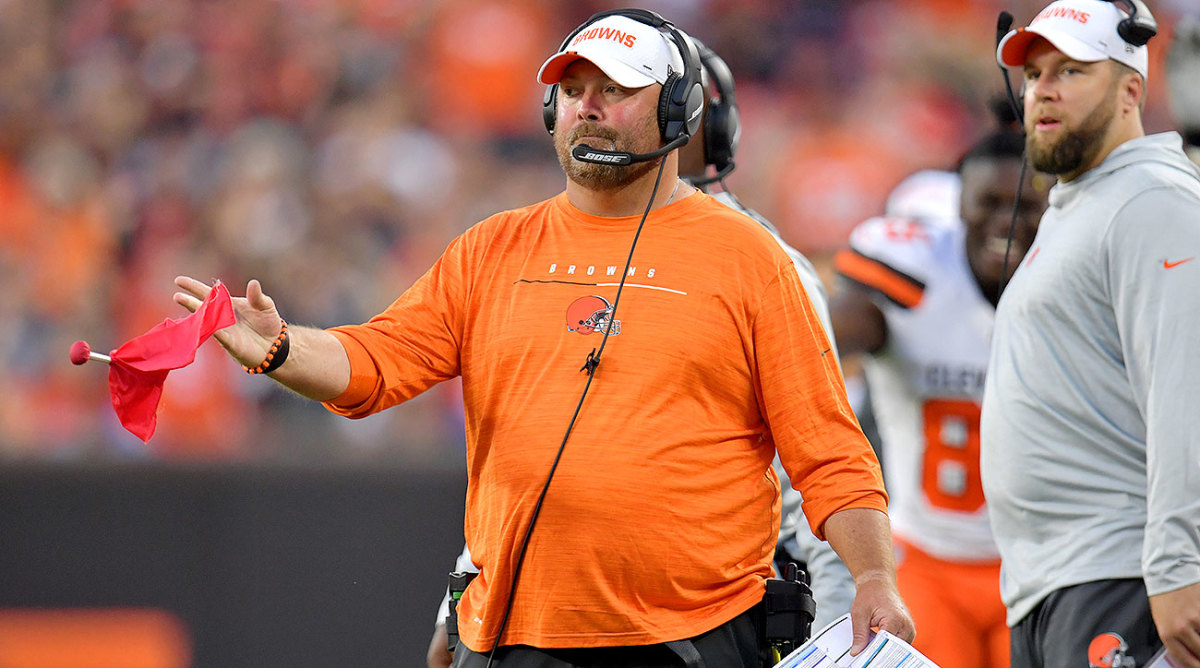
Freddie Kitchens always wanted to be a head coach, but he was never deemed the sort of wunderkind who gets a pass on paying his dues. The good ol’ boy with the Alabama twang first oversaw running backs and tight ends at D-II Glenville (W.Va.) State; he bounced to LSU, North Texas and Mississippi State, then to the Cowboys and the Cardinals, where he spent 11 years in various roles before leaving after the 2017 season. That winter he was looking at job openings, weighing possibilities, and found himself thinking back to his career as a QB at Alabama, an iconic team with a historic past. And in his mind the Browns were pro football’s version of the Crimson Tide, helmet immediately recognizable. “I liked what this franchise represents,” he says. “In theory it represents the NFL.”
Kitchens had always wondered why the Browns struggled since returning to the league. In this business, he too thought, you can’t be scared of a challenge. So when Cleveland offered him a job to work with their running backs, he accepted. And what unfolded next is already regarded on the southern shores of Lake Erie as historic: Dorsey’s stopgap QB, Tyrod Taylor, getting knocked out in the first half of a Week 3 game against the Jets; Mayfield entering down 14–0; the stadium erupting; the team rallying to win 21–17. Dorsey drove home after the victory, the team’s first in more than 600 days, with his windows rolled down, watching the fans dance and sing. “You could feel the frustration come out,” he says.
The GM made his next big move five weeks later, firing both coach Hue Jackson and offensive coordinator Todd Haley, who had been feuding, then sliding Kitchens into Haley’s role. Dorsey watched as his new coordinator added zone reads and options to cater to Mayfield, who then shattered the NFL rookie record for touchdown passes (27). Running back Nick Chubb, another class of ’18 draftee, who hadn’t had more than three carries in the first six games, would set the team’s rookie rushing mark by year’s end, and the Browns would claim more victories in November and December than in the previous three full seasons combined.
Entering the winter in search of a new coach, Dorsey put together a committee to find a “leader of men” and whittled an initial list of 20-plus candidates to eight. Even Kitchens, the folksy assistant who’d always believed he deserved an opportunity but was never deemed worthy, didn’t think he’d get the job. After he made the first cut, he went into his interview with one objective: “I was going to present myself as me.”
After two months of looking, the committee came to what Dorsey says was a unanimous decision. “I think Cleveland fits me pretty well,” says Kitchens, 44, who was officially promoted on Jan. 12. “I had to fight for everything I ever got, and a lot of people in Cleveland do the same thing. They are looked at as never being good enough.”
The same can be said of his young quarterback, who carries with him the anger of perceived recruiting slights in college, seemingly making headlines every other week with another display of confidence—or arrogance, depending on your perspective. It’s an attitude Clevelanders say is perfectly tailored to a city that has long been dealing with an inferiority complex, and Kitchens has no problem with it. “Why would I want to change Baker?” he asks. “That’s what makes him him. Nobody is going to change me—why would I change someone else?”
Dorsey made it a priority this offseason to surround the young passer and the first-time coach with more talent on both sides of the ball. In February he signed 2017 NFL rushing leader Kareem Hunt, whom the Chiefs cut last year after a video surfaced showing him kicking a woman. (Dorsey drafted Hunt in Kansas City and, for better or worse, says he believes in second chances.) In March the GM traded for Giants defensive end Olivier Vernon and signed free-agent D-tackle Sheldon Richardson, both former Pro Bowlers; paired with end Myles Garrett, the No. 1 pick in 2017, they form one of the most formidable lines in the league.
Dorsey wasn’t done, though. Four days after the Vernon deal he called back New York GM Dave Gettleman and asked a simple question. “What about Odell?”
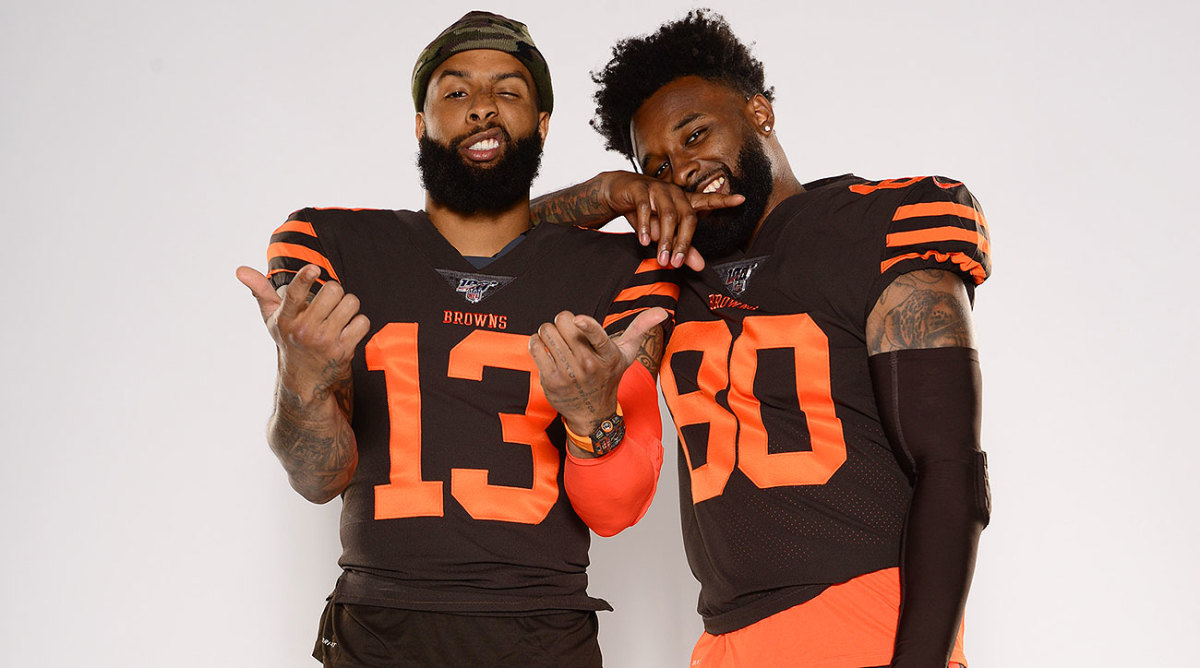
Jarvis Landry has started to fill in Odell Beckham Jr. on the Browns’ history: the early dynasty, the move to Baltimore, the cosmic connection between city and team. Everything Landry learned last season he now gets to share with his best friend.
When the receivers first met as high schoolers in Louisiana, living just 50 miles apart, they each quickly found a kindred spirit: Both are passionate, heart-on-their-sleeve types. They decided to play together at LSU and openly daydreamed about reuniting in the NFL, owning houses nearby, “doing legendary s---,” Landry says.
Beckham was naturally gifted, but he credits Landry with teaching him how to work. The two would break into the Tigers’ facility in the middle of the night to train, launching footballs at one another from close distance, catching them with one hand. “That all came from him,” says Beckham.
The 2014 draft sent them separate ways, and both became instant stars. But they were also disgruntled, playing on noncompetitive teams in unimaginative offenses. If one was watching the other on TV, he would send encouraging texts at halftime. Keep working. Keep your head in it. I see you open, it’s going to come.
“It’s been hard,” Beckham says. “We both needed each other.”
For Beckham fame came in just the seventh game of his career, with a spectacular one-handed catch against the Cowboys on Sunday Night Football. He was instantly one of the most marketable players in the league—good-looking and charismatic, with a trademark two-toned faux-hawk, infectious smile and dance moves kids would emulate. With sweeping popularity, though, came scorching criticism. “I was talked about as if I was a celebrity who had the luxury of playing football,” he says. “It got to the point where it wasn’t really about football anymore. It was politics.”
He takes partial responsibility for some of this. “I can’t be like, ‘I’ve never done anything wrong,’” he says. His emotional outbursts—whether fighting cornerback Josh Norman or a kicking net—invited that scrutiny. But Beckham believes he got more attention for those lapses than for his exceptional play on the field; he feels he was overly criticized by the New York media and constrained in so many ways by the Giants. “They built something that they now wanted to control,” he says, “and there is no need to try to control it.”
On the topic of his old quarterback, Beckham has nothing bad to say. He and Eli Manning were “cool” but not friends, teammates who didn’t “hang out outside” of football. He laments, however, that coaches tended to feature him only on third downs, that the offense never schemed for his abilities, that he ran slants so frequently that defenders would call out his routes presnap. The Giants are “stuck in an older mindset,” Beckham says. Then he clarifies: He’s not trying to take “shots—just speaking facts.”
Last May, after Landry was traded to Cleveland, the two old friends met up with the new Browns QB to train at USC. With Beckham outside, Landry in the slot and Mayfield running around firing spirals, they all dreamed, somewhat jokingly, of playing together. “We didn’t think it was possible,” Landry says. “We wanted it to be. Like: ‘Bro, damn. What if ... ’”
Beckham, deep down, had long believed the Giants would trade him. He says this explains why he never bought a house in the New York area. Then last October, five weeks after signing a five-year, $95 million extension that made him the highest-paid receiver in the league, he aired his frustrations to ESPN, leading to a fine from the team. He was convinced he was gone.
When Dorsey called Gettleman on March 11, it marked the first conversation the two GMs had had about Beckham, and it was straightforward. Dorsey made an offer; Gettleman countered; Dorsey hung up. This was 4:30 p.m. Dorsey told his fellow staffers, “Damn, we may have a chance.”
Beckham was heading to a restaurant in Paris when he got the call from Gettleman. He didn’t want to answer. He knew he was getting traded; he just didn’t know where. The conversation, he says, lasted seconds.
In a situation like his, Beckham says, a star player will often get a chance to discuss his preferred trade destinations. But he was never asked. In fact, he claims to know that the Giants received better offers and still chose to send him to Cleveland, out of spite, hoping to stain his career with the enduring stigma that comes with playing for the Browns. “This wasn’t no business move,” he says. “This was personal. They thought they’d send me here to die.” (The Giants declined to comment on Beckham’s exit.)
These, though, are not those same Browns. Beckham believes he’s perfectly matched with Kitchens, an imaginative schemer, and Mayfield, who reflects Beckham’s frenetic energy on the field and has already defended the receiver against criticism.
“I’ve never had that before,” Beckham says.
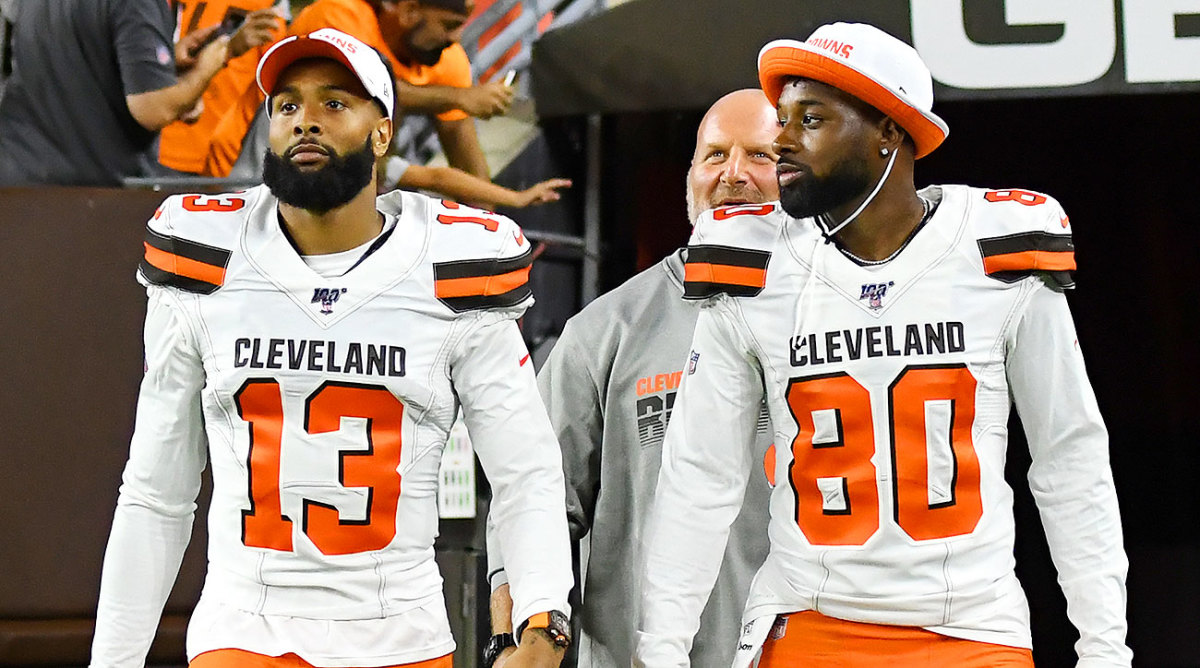
Now he HAS his best friend again too. Landry cried when he heard the news in March. He assured Beckham that in Cleveland the past would be the past, that he’d be allowed a fresh start. “Just come be you,” he said. Then Beckham put down an offer on the house across the street from his old friend, fulfilling their childhood dream.
The two receivers know there’s work to be done. Talent alone doesn’t win championships—“How many playoff games have they played in?” Kitchens asks of his offensive stars; “How many Super Bowls?”—but Cleveland boasts so much of it that new challenges may be on the horizon.
Dorsey believes any potential issues having to do with a glut of offensive firepower will be offset by Mayfield’s “unique way of distributing the ball.” (Of his 27 touchdowns last season, no player caught more than four.) Beckham, for his part, thinks any such problems will sort themselves out. “Somebody,” he says, “is going to put that motherf----- in the end zone.”
All the receiver wants now is “to play football and not deal with the extra stuff”—he even shaved off his golden curls as proof. He laments, though, that the media doesn’t appear willing to let him start fresh, pointing out all the attention he already received for skipping voluntary OTAs in May.
He and Landry push back on the notion that Cleveland’s combination of locker room personalities could be combustible. From their viewpoint, they’ve simply been misunderstood—the same way people classify anything else they don’t understand, to make them feel more comfortable. Like UFOs, Beckham says.
Dorsey, meanwhile, has been listening this offseason to Public Enemy’s rap anthem “Don’t Believe the Hype” and relaying that message to his players. He reminds everyone that, despite all their success last year, the Browns finished third in the AFC North. “We ain’t done s---,” he says, suggesting a magazine headline along the lines of unfinished business. He’ll push that message on his players daily—that and, of course, Don’t Be Scared.
In Landry’s eyes, the message is getting through. Last season he saw how the pall that had long covered the franchise still affected his teammates. It was in the locker room culture he was fighting so hard to overhaul, and on the field, where he felt refs didn’t give his team any calls, as if Cleveland were fighting not just its opponents but its own history. He believes that changed, though, once Mayfield took over and Kitchens was promoted and the wins started to string together. “That stigma, that aura that was always over the Cleveland Browns,” he says. “I can feel it coming off.”
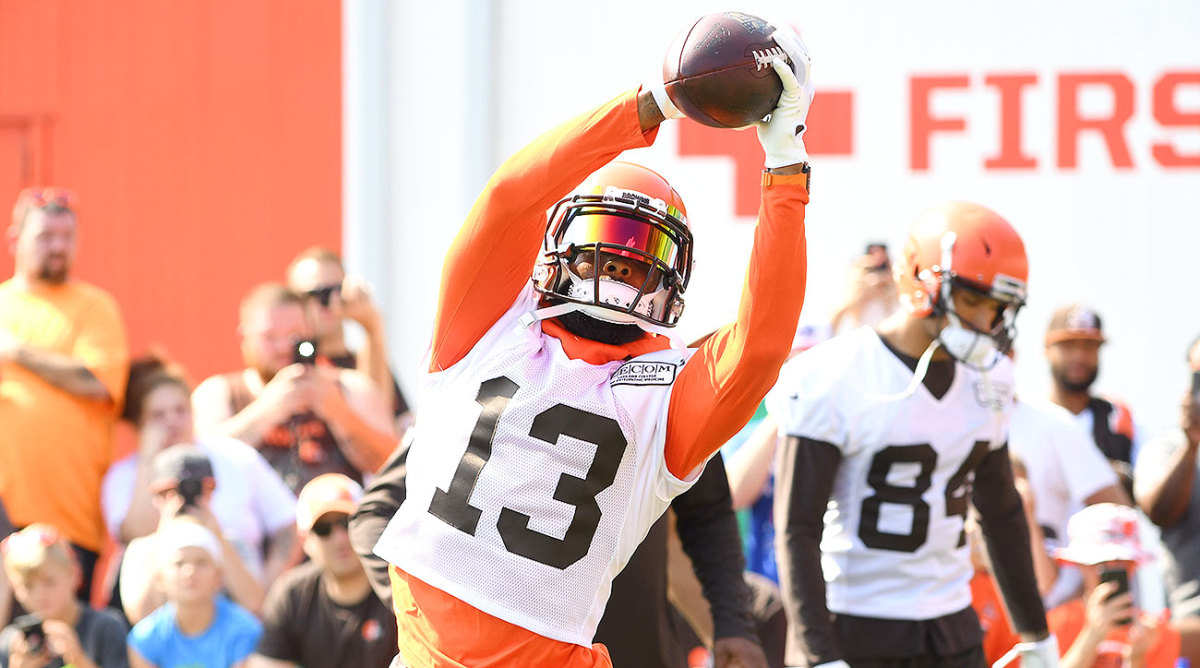
Three months before their most anticipated season in decades, six Cleveland diehards sit outside a downtown bar, drinking beers and smoking cigars and comparing Browns tattoos. Some of them were there when the team won its last championship, 55 years ago. Others helped create the rabid Dawg Pound seating section, famed for its fans wearing dog masks and for fighting visiting fans. They still go by names like Big Dawg and D Dawg and Dawg Face. They believe it’s their obligation to support the team, always.
“We’ve seen it all.” “The dynasty.” “The heartbreak.” “We always have had hope.” “That’s how we are raised in Cleveland.” “We don’t give up ...”
They remember the early years: the Browns’ foundation in the All-America Football Conference, in 1946, and how they promptly won their first title; how they joined the NFL in ’50 and won a championship right away there, too. How in the first 10 seasons they won seven titles, then added an eighth in ’64, in Cleveland. Some rushed the field that day, climbed the goalposts.
“... We still have eight championships.” “That means something.” “It’s part of history.” “Our history ...”
Cleveland was booming back then, its economy flourishing, its population approaching one million. But by the 1960s the town’s steel and iron factories were closing, and people fled en masse, the city left so polluted that in ’69 the Cuyahoga River turned inferno after debris caught fire, still a source of embarrassment. Still, even when Cleveland defaulted on bank loans in ’78—the first American city since the Great Depression to do so—the stadium remained packed.
That was the era of Brian Sipe and Bernie Kosar, and the fans were desperate then. The Browns imbued them with a pride they couldn’t often find elsewhere, even with all the heartbreak. Red Right 88. The Drive. The Fumble. So when Modell called a noon press conference in November 1995 and announced he was moving his team, the city responded with fury: lawsuits, protests, thousands of orange postcards mailed to league headquarters, countless more faxes and phone calls demanding injustice be righted. Modell fled on a private jet and never returned.
“... I took three days off work just to fax letters.” “I didn’t watch football for four years.” “A piece of us was taken.” “It’s our team.”
Now these six men sip their beers and reflect on the past, on the decades when they had to bribe their grandchildren to attend games. But they also envision their future. They feel, with their shared histories, more connected with this team than any before. The GM and the coach and the quarterback—they understand us. Those castoff receivers—they, too, want to rethink labels, like the ones ascribed to this city for so long.
They are optimistic, of course. And cautious, of course, after all they’ve been through. They talk about a home playoff game, a winning season—or just winning the first game of the season, which the Browns haven’t done since 2004. They’re actively trying to manage expectations, but they also want to enjoy the ride, this feeling that they haven’t had in so long, anticipation mixed with apprehension. Still. They can’t help but wonder what it would mean for the Browns—their Browns, the old soul-of-the-city Browns—to return.
“... It’ll go back to like how we know it.” “How it should be.”
Question or comment? Email us at talkback@themmqb.com.
